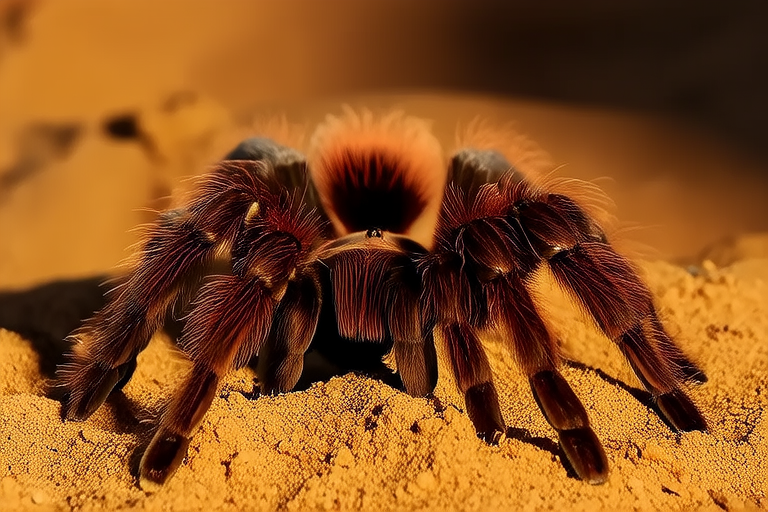Tarantula Tidbits: Care Guide for First-Time Chilean Rose Owners
Welcome to the world of tarantula ownership! If you’ve just brought home your first Chilean rose tarantula (Grammostola rosea), congratulations! These fascinating creatures are popular among arachnid enthusiasts due to their manageable size, docile temperament, and striking appearance. This comprehensive care guide will help you set up a suitable habitat, understand their dietary needs, learn how to handle them safely, recognize potential health issues, and debunk common myths about tarantulas.
Habitat Setup
Creating a comfortable environment for your Chilean rose tarantula is crucial for its well-being. The enclosure should mimic its natural habitat as closely as possible while ensuring safety and ease of maintenance.
- Enclosure Size: A 10-gallon tank or equivalent is sufficient for an adult Chilean rose tarantula. Ensure there’s enough space for it to move around comfortably without feeling cramped.
- Substrate: Use coconut fiber, peat moss, or a mix of both as substrate. It should be at least three inches deep to allow burrowing behavior typical of this species.
- Hide Spot: Provide a hide spot made from cork bark, half logs, or plastic plants. This gives your tarantula a place to retreat when it feels threatened or wants privacy.
- Temperature and Humidity: Maintain temperatures between 75°F and 85°F (24°C – 29°C) and humidity levels around 60%. You can achieve this by misting the substrate occasionally and providing a water dish.
- Lighting: Avoid direct sunlight as it may cause overheating. Instead, use a low-wattage heat lamp if necessary, but ensure it doesn’t exceed the recommended temperature range.
Feeding Habits
Chilean rose tarantulas are opportunistic feeders that consume various insects. Here’s what you need to know about feeding your pet:
- Diet: Feed your tarantula crickets, mealworms, superworms, or dubia roaches. Dust these feeder insects with calcium powder before offering them to enhance nutrition.
- Frequency: Feed adults once every one to two weeks. Juveniles may require more frequent meals, but always monitor your tarantula’s weight and adjust accordingly.
- Handling Prey: Always use feeding tongs to place prey items inside the enclosure. Never hand-feed your tarantula, as this could lead to accidental bites.
Handling Tips
While tarantulas might seem intimidating, they are generally docile and can be handled safely with proper precautions:
- Preparation: Wash your hands thoroughly before handling your tarantula. Gently scoop it up using a soft, flat tool like a paintbrush or foam brush.
- Position: Support the tarantula’s body by gently holding its abdomen while keeping the legs free. Never squeeze or hold it too tightly.
- Duration: Limit handling sessions to avoid stressing your pet. Short, infrequent interactions are ideal.
- Post-Handling: After handling, return your tarantula carefully back into its enclosure. Monitor it for any signs of stress or injury.
Health Concerns
Regular observation is key to maintaining your tarantula’s health. Here are some common issues and how to address them:
- Shedding: Tarantulas shed their exoskeleton periodically. During molting, provide extra moisture and avoid disturbing the tarantula until the process is complete.
- Regurgitation: If your tarantula regurgitates after eating, it may indicate overfeeding or stress. Reduce feeding frequency and create a more peaceful environment.
- Mites: Check regularly for mites, which appear as tiny red dots on your tarantula’s body. Treat infestations promptly with appropriate medications.
Common Myths About Tarantulas
There are many misconceptions surrounding tarantulas. Let’s clear up some of the most prevalent ones:
- Myth: All tarantulas are dangerous. Fact: While all tarantulas have venom, only a few species pose significant risks to humans. The Chilean rose tarantula has mild venom and is considered safe for experienced handlers.
- Myth: Tarantulas eat constantly. Fact: In the wild, tarantulas eat opportunistically based on availability. Overfeeding in captivity can lead to obesity and other health problems.
- Myth: Tarantulas bite aggressively. Fact: Tarantulas prefer to flee rather than fight. They only bite when provoked or feel threatened.
Conclusion
Owning a Chilean rose tarantula is a rewarding experience that requires dedication and attention to detail. By following the guidelines outlined in this care guide, you’ll be able to provide your pet with a healthy, happy life. Remember, each tarantula is unique, so observe your pet closely and make adjustments as needed. Enjoy the journey of learning about these incredible creatures!
